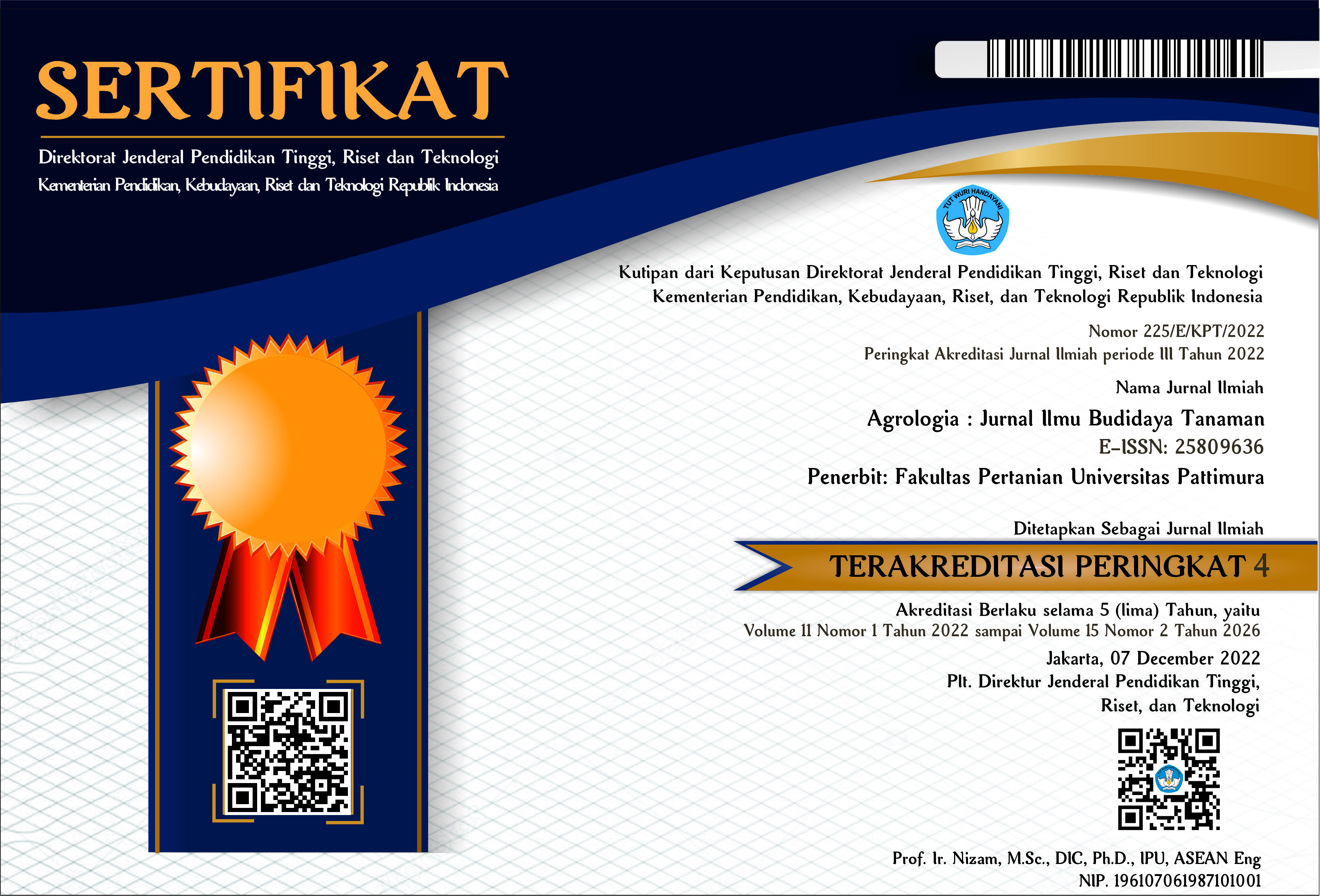The use of Trichoderma harzianum to control the Bottom Pathogenic Fungus of Rice Seed (Oryza zativa L.) from breeders in Waeapo District, Buru Regency
Abstract
Healthy seeds are needed to support the food crops growth and yield. This study was aimed to 1. identify the types of pathogenic fungi on rice seeds in Waeapo District, Buru Regency; 2. Asses the fungal pathogen effect on the growth of rice cv Ciherang seedings; and 3. determine the ability of Trichodema harzianum to control those fungus and its effect on the germination of rice. The research consisted of foure stages, namely 1. Isolation and identification of the bottom pathogenic fungi of rice seeds; 2. Pathogenicity test of the pathogens; 3. Antagonistic test of T. harzianum against pathogens in vitro, and 4. Bioassay of T. harzianum inoculation to pathogen-infected rice seeds. The research found that pathogenic fungi isolated from rice seeds from breeders in Waeapo District were Mucor sp., Sclerotium sp., Aspergillus sp., Rhyzoctonia sp., and Drechslera sp., which cause the rice seeds damage of 13.33 %, 10.37%, 11.85%, 11.11%, and 12.59% respectively. In vitro assay verified that T. harzianum was able to suppress the development of pathogens Mucor sp., Sclerotium sp., Aspergillus sp, Rhyzoctonia sp., and Drechslera sp. up to 46.99%, 67.48%, 55.83%, 55.42%, and 31, respectively. 60%. The inoculation of T. harzianum to infected rice seeds, reduced the rice damage by Mucor sp, Sclerotium sp, Aspergillus sp, Rhyzoctonia sp, and Drechslera sp, up to 79.14%, 18.72%, 17.97%, 18, respectively. 71% and 61.40% respectively.
Keywords
Full Text:
PDFReferences
Balai Besar Penelitian Tanaman Padi. 2008. Mutu Benih Tanaman Pangan. Balai Besar Penelitian Tanaman Padi. Jawa Barat.
Sutopo, L. 2002. Teknologi Benih. Rajawali Press. Jakarta
Sutopo, L. 1993. Teknologi Benih. PT. Raja Grafindo Persada. Jakarta
Sobianti, S., Soesanto, L dan S. Hadi. 2020. Inventarisasi Jamur Patogen Tular-Benih Pada Lima Varietas Padi. Agro Bali : Agricultural Journal 3 (1): 1-15.
Nurdin, M. 2003. Inventarisasi Beberapa Mikroorganisme Terbawa Benih Padi yang Berasal dari Talang Padang, Kabupaten Tanggamus, Lampung. 3(2): 47-50.
Irawan, A. 2019. Penyakit Sclerotium Pada Tanaman Padi (Oryza sativa L) https://agrokomplekskita.com/penyakit-sclerotium-pada-padi/
Sumartini, 2011. Penyakit Tular Tanah (Sclerotium rolfsii dan Rhizoctonia solani) Pada Tanaman Kacang kacangan Dan Umbi-Umbian Serta Cara Pengendaliannya. Jurnal Litbang Pertanian, 31(1): 27-34.
Turnip A., Efri, dan J. Prasetyo. 2015. Pengaruh perlakuan Benih dengan Trichoderma viridae dan Pseudomonas fluorescens Terhadap Keterjadian Penyakit Bulai (Peronosclerospora maydis) pada Berbagai varietas jagung (Zea mays L.). J. Agrotek Tropika 3 (2): 216-219.
Martinius, Darnettu, Trizelia dan S. Herlina. 2017. Kemampuan Trichoderma endofitik Dalam Mengendalikan Jamur Patogen Tular Benih Cabai. Laporan Penelitian Fakultas Pertanian Universitas Andalas.
Simbolon, B.A.S. 2016. Aplikasi Trichoderma sp. Untuk Mengendalikan Serangan Fusarium oxysporum f.sp. lycopercii Pada Tanaman Tomat Cung (Lycopersicum esculentum Mill.). [Skripsi] Universitas Bengkulu.
Dalame, E.D., Sumayku, B., dan Mamdang. 2019. Penggunaan Trichoderma Koningii PADA Perkecambahan Sirsak (Annona muricata linn). Agri-Sosio Ekonomi 15(5): 563 - 572
Kalay, A.M., Talahaturuson, A, dan W. Rumahlewang. 2018. Uji Antagonisme Trichoderma harzianum Dan Azotobacter chroococcum Terhadap Rhyzoctonia solani, Sclerotium rolfsii dan Fusarium oxysporum secara in-vitro. Agrologia 7 (2): 71-78.
Kalay, A.M., Hindersah, R., Talahaturuson, A. and A.I. Latupapua. 2017. Dual inoculation of Azotobacter chroococcum and Trichoderma harzianum to control leaf blight (Rhizoctonia solani) and increase yield of choy sum. International J. of Scientific & Engineering (8): 1288-1292.
Harman, G. E. 2006. Overview of mechanisms and uses of Trichoderma spp. Phytopathology 96: 190-194.
Gultom, J.M. 2008. Pengaruh Pemberian Beberapa Jamur Antagonis dengan Berbagai Tingkat Konsentrasi Untuk Menekan Perkembangan Jamur Phytium sp Penyebab Rebah Kecambah pada Tanaman Tembakau (Nicotiana tabaccum L.) http://repository.usu.ac.id.pdf [06/02/2017].
Barnett, H.L. dan B.B. Hunter. 1999. Illustrated Genera Of Imperfect Fungi. The American Phytopathological Society. St. Paul, Minnesota.
Singh, K. dan S.B. Mathur. 1991. An Illustrated Manual on Identification of Some Seed-borne Aspergilli, Fusaria, Penicillia, and their Mycotoxins. Institute of Seed Pathology for Developing Countries. Denmark.
Cambell, C.K., Johnson, E.M. and D.W. Warnock. 2013. Identification of Pathogenic Fungi. Second Edition. Wiley-Blackwell. A. John Wiley & Sons, Ltd., Publication.
ISTA. 2007. International rules for seed testing edition 2007. International Seed Testing Association, Switzerland.
Gaigole, A.H., Wagh, G.N and A.C. Khadse, 2011. Antifungal activity of Trichoderma spesies against soil borne pathogen. Asiatic J. Biot. Resour 4: 461-465.
Phan, L.T.K., Tran, T.M., Audenaert, K., Jacxsens, L. And M. Eeckhout. 2021. Contamination of Fusarium proliferatum and Aspergillus flavus in the Rice Chain Linked to Crop Seasons, Cultivation Regions, and Traditional Agricultural Practices in Mekong Delta, Vietnam. Foods 2021, 10, 2064.
Irawan, A. 2019. Penyakit Sclerotium Pada Tanaman Padi (Oryza sativa L) https://agrokomplekskita.com/penyakit-sclerotium-pada-padi/
BPTP. 2019. Busuk Batang (stem rot) pada padi. Balai Pengkajian Teknologi Pertanian (BPTP) Sulawesi Selatan,
http://old.sulsel.litbang.pertanian.go.id/ind/index.php?option=com_content&view=article&id=790&Itemid=322
Sopianela. 2017. Segitiga Penyakit Tanaman. Mulawarman University Press. Samarinda.
Inayati, A., Sulistyowati, L., Aini, L.Q and E.Yusnawan. 2019. Antifungal activity of volatile organic compounds from Trichoderma virens. AIP Conference Proceedings > Volume 2120, Issue 1 > 10.1063/1.5115750.
Lynch, J.M. 1987. In vitro Identification of Trichoderma harzianum as a potential antagonistic of plant pathogens. Curren Mikrobiol; 16:49-53.
DOI: http://dx.doi.org/10.30598/ajibt.v11i1.1540
Refbacks
- There are currently no refbacks.

This work is licensed under a Creative Commons Attribution-NonCommercial-ShareAlike 4.0 International License.











